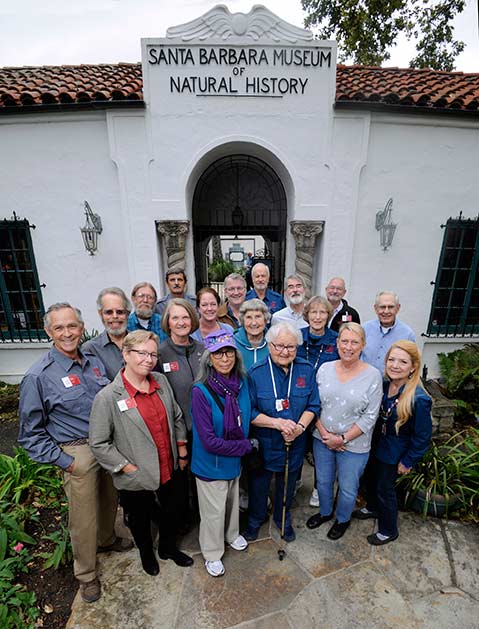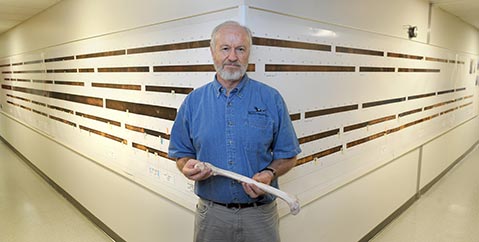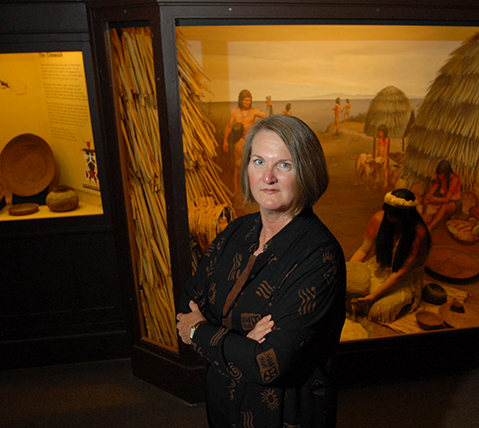
In January 1916, a minister turned ornithologist named William Leon Dawson indulged his fascination with bird eggs by opening the Museum of Comparative Oology at his home just up creek from the Santa Barbara Mission. By 1923, public pressure to showcase something other than eggs forced Dawson out, and the Museum of Natural History as we know it sprang forth.
Today, while a casual visitor may assume that the focus is merely on the plants, animals, and past people of our region, the museum’s mission is truly multifaceted. There’s active research on both land and sea, myriad educational offerings for schoolkids of all grades, and a steady schedule of events both informative and fun for adults. Those efforts, which also occur at the museum’s Sea Center on Stearns Wharf, have exponentially grown over the decades, and will continue to do so under recently approved renovation plans that will further emphasize the museum’s unique mix of outdoor and indoor experiences.
Making this all happen during the past century are legions of staff members and volunteers, many of whom have spent their entire careers and/or much of their lives dedicated to this place. Here’s a dossier on just a few of those important veterans, without whom there’d be no museum at all.
Hebe Bartz
Carpinteria native began volunteering for the museum almost 50 years ago.
Why? “Propinquity and a longtime affection for the place, visits as a kid, knowing Cookie and her daughter, Barbara, from Girl Scout Camp, curiosity, a passion for learning (thank you, Pomona College), and the joysome happenstance of finding a house just up the street when we were looking to move from Carpinteria. The truth of it is that I have received so much more out of it than I have put into it.”
Next 100 years? “In tune with changing times and holding fast to what has gone before. I just wish I could be there.”
Larry Bregante
Head (and only) groundskeeper of the museum’s 11.5 acres since August 1, 1977. “I probably wasn’t the most qualified or experienced, but they took a chance on me, and it worked out pretty good.”
Changed much? “Looking back almost 40 years, it’s steadily gotten better and better. It’s an upward trend.”
Most rewarding? “The growing emphasis on highlighting the museum grounds as an educational tool and extension of what’s exhibited inside. It’s a terrific setting for a natural history museum, and we’ve been taking more advantage of that.
Tree gazing? The redwoods he planted as five-foot-tall saplings are now more than 80 feet in height. “It’s kind of special to be able to stick around long enough to see that.”
Paul Collins
Curator of Vertebrate Zoology, a department he’s served for 43 years.
Projects? Worked with wildlife through the Central Coast, from the Channel Island foxes to Vandenberg bats. Also helped with the blue whale skeleton, recovering the skeleton in the 1980s and repairing it recently.
Favorite memory? “From the earliest years back in the late 1960s when I would visit the museum’s bird hall to help learn to identify the birds of our region.”
Six words or less? Amazing, cherished institution for this size community.
Krista Fahy
Associate curator of Vertebrate Zoology celebrates 22 years of work this month.
Proud accomplishments? Getting the museum “into the electronic age in terms of networking, email, and a webpage!” Also digitizing the vertebrate collections and redesigning the bird hall.
Favorite memories? “Since I have spent almost half my adult life as an employee, I have so many memories that I can’t think of just one. Most of them deal with field trips we led, school groups getting super excited about the stuff behind the scenes, and memories of some amazing mentors who shared their vast knowledge with me that have now passed on.”
Next 100 years? “With each passing year, the relevance of material we have in our collections grows more and more valuable to the scientific community.”
Jan Hamber
Coornell graduate that moved to Santa Barbara and started volunteering in September 1959. Hired as assistant curator in 1969, just before the oil spill.
Condor love? Started working on California condors with Dick Smith in 1976 and presently is the museum’s condor biologist. “I was part of an amazing group of biologists who worked incredibly hard and helped save the California condor from extinction.”
Favorite memory? “The time I stood in the roiling surf and helped clean the flesh of the blue whale that had come ashore at Vandenberg AFB.”
Next 100 years? “I just hope they keep the simple personal touch and not go with fancy technology that removes a person from the real world.”
Kathy Harbaugh
Science teacher who started volunteering when she had young kids in 1983. Manager of teacher services 2008-2015; still a docent.
Favorite corner? The nature clubhouse. “So many of the kids from Santa Barbara to Ventura have never been to the beach or to a creek. So it’s really amazing that they can come outside and experience nature.”
Affected her kids? “All that exposure really clicked with my youngest one — she ended up with a doctorate in biology.”
Why special? “It’s a classic campus. It’s a friendlier sort of feel. It’s different than a big museum where everything is behind glass in huge halls. It’s intimate.”
Eric Hochberg
Curator of the Invertebrate Zoology Department for 40 years, researching everything from sea shells to the kidney parasites of squid and octopus since 1973. Retired four years ago.
Working with college students? “I’ve had PhD students from the U.S., Canada, Spain, Australia, Mexico, France, Colombia, and around the world. It gives them a really good connection with the facility.”
Extracurricular affairs? Started the Nature Printing Society in the mid-1970s. “That’s given me a balance to the scientific and technical studies and taken my career in a whole other direction. In a bigger or even small museum, I would not have been able to do that. We are just the right size and location.”
Next 100 years? “It will be critical to keep showcasing the diversity of life.”

Santa Rosa Island in 1959 — such as the replica of a left femur he holds in his hands — were actually 13,000 years old.
John Johnson
Department head and Curator of Anthropology since 1986.
Why? “A fascination with Chumash culture and prehistory of our region. My father was a high school biology teacher, and as children, my brothers and I would accompany him on field trips with his students to the L.A. County Museum of Natural History. I loved the wonderful exhibits of prehistoric animals and wildlife dioramas and dreamt of someday working for a natural history museum. It eventually worked out that this dream came true.”
Projects? Chumash ethnohistoric studies that have shed light on Chumash culture and history; archaeological exploration at Arlington Springs, Santa Rosa Island, that has yielded the earliest evidence for people in our region; DNA studies to discover distinctive genetic patterns that reflect past migrations that peopled California. Also his collaboration with Chumash elder Ernestine De Soto and filmmaker Paul Goldsmith to cowrite and produce 6 Generations, which tells the story of the experience of women in six generations of a Barbareño Chumash family. “I regard that experience as one of the highlights of my tenure at the museum.”
Loyda Marquez
After 39 years of teaching at Harding Elementary School, retired and became a docent in 1999.
Why? “To expand children’s minds, to help them see the world in a different way. Perhaps they will be more mindful of nature and think responsibly instead of being self-centered. Books are fine, but you can do more than that.”
Nature’s effect on kids? “It shaped their lives to a large extent. They are very mindful of what they do with the land they are on.”
Ros Perry
Moved here from East Coast in 1976, and started to volunteer as a docent in 1979. Also served on the board.
Antidote to iPads? “With the growth of screen time, the time kids spend out in nature has really decreased. The museum is spearheading an effort to bring kids to the backyard of the museum where they can explore in the soil and the water and learn so many things.”
Working with scientists? “We’ve just had phenomenal opportunities to interact with the staff. I have huge admiration for the dedication and the amount of work they do, and their willingness to share all of this with the docents.”
Good vibes? “Everybody is so positive and engaging and supportive. It’s a very enjoyable facility. It’s really been a happy part of my life.”
Sandy Russell
Docent for 16 years; also volunteer in Invertebrate Zoology working on butterflies.
Favorite corner? The Butterfly Pavilion. “It draws in so many visitors for an awesome educational experience with nature, and also for the real effect of a healthful connection and attunement with the natural world while stimulating curiosity and promoting more personal involvement. It’s not just an exhibit when visitors ask, ‘How can I do this at home in my garden?’”
Best memory? “Seeing my grandson start walking for the first time across the Smokey Bear exhibit hall just so he could get there faster to roar at the grizzly mount. Fierce motivation!”
Six words or less? Real Nature: under glass and under your feet!
Fredrick Schaeffer
After a career in electronics, joined Anthropology Departments as a volunteer 21 years ago.
First visit? With future wife in 1957. “It was a wonderful experience, and I have loved the museum ever since.”
Proudest accomplishment? Compiling and calibrating the museum’s radiocarbon dates.
Advice for future? “Never get rid of the rattlesnake; it is a joy to watch the kids push the button.”
Terri Sheridan
Hired in 1986 as teacher, became assistant librarian in 1987 and head librarian in 1992.
Lotsa books? “The library collections here are vast, varied, and infinitely interesting. I get to work with researchers from all over the world helping them to piece together their own research puzzles that, in turn, lead to answering a myriad of questions regarding the natural world and how humans have interacted with it for thousands of years. I’m a knowledge junkie.”
Hidden treasures? “A lot of the work I do on a day-to-day basis is invisible to most people — developing and processing collection material to make it available for research is not particularly glamorous. However, I find it very rewarding when people, no matter who they are, find what they’re looking for among our collections.”
Next 100 years? “We have the magic. We have it all, from passive, contemplative programs, exhibits, study, and scenery to wild get down and dirty, touch it all, nature discovery, adventure, and play. This is a place where everyone experiences the environment in just the right way for them.”

in journals, the Museum of Natural History’s research immediately flows into
the public sphere. “Scientists have a sacred responsibility to share their research
and their findings with the public,” believes anthropologist Jan Timbrook.
“That’s what we do here.”
Jan Timbrook
Started as volunteer in summer of 1973; hired in January 1974. Currently curator of ethnography. “That’s important sounding, but no one knows what it means. It’s cultural anthropology. I get to take care of the pretty things.” Like baskets, pottery, etc.
Sharing knowledge? “Scientists have a sacred responsibility to share their research and their findings with the public. That’s what we do here.”
Proudest accomplishment? Her 2007 book, Chumash Ethnobotany, now in its third printing. “That took 30 years of research off and on to pull it all together, so it’s basically my life’s work.”
Adults, too? “So many people say, ‘Oh, gosh, what a great place. I haven’t been there since my kids were little.’ People think it’s only for children. That’s missing so much of what we do. It’s really important we educate adults and not just children.”
Paul Valentich-Scott
Marine biologist since 1982; Curator of Malacology.
What’s work like? “Our amazing museum allows us to do cutting-edge research and work with schoolchildren on the same day. It is a wonderful combination of excitement and discovery, and humbling at the same time.”
Favorite memory? “I always love watching ‘the light go on’ when a visitor understands a challenging biological concept. When we do “behind the scenes tours,” so many visitors are stunned by what we don’t know about our planet, but also what we are discovering every day. They begin to understand why we do research and why it matters.”
Six words or less? Beautiful, inspiring, jaw-dropping, playful, discovery, natural.



